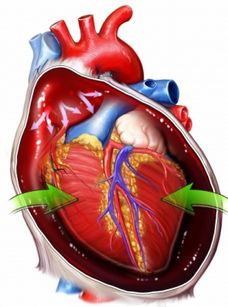Cardiac tamponade
Description of cardiac tamponade
Cardiac tamponade occurs, between when the heart muscle and the surrounding tissue, It called pericardial, fluid accumulates. This fluid compresses the heart. Because of this the heart can not pump enough blood.
This disease can be life-threatening. With proper treatment the prognosis tamponade heart good. However, cardiac tamponade may may recur even after treatment.

Causes of cardiac tamponade
Stopped heart may cause a number of factors and disorders, including:
- Perikardit – inflammation of the bag, that surrounds the heart. It is the result of bacterial or viral infections;
- Bleeding into the pericardium, caused by trauma;
- Rupture of the heart muscle;
- Cancer near the heart.
Risk factors for cardiac tamponade
Factors, which increases the likelihood of cardiac tamponade:
- Heart surgery;
- Tumors in the heart;
- Heart attack;
- Damage to the Heart;
- End-stage lung cancer;
- Renal failure;
- Radiation therapy in the chest;
- Gipotireoz;
- Systemic lupus erythematosus.
Symptoms of cardiac tamponade
Cardiac tamponade symptoms range from mild to severe forms of. Usually, they include one or more of the following problems:
- Fatigue and sleepiness;
- Breathlessness, fast or difficult breathing;
- Dizziness;
- Chest pain:
- Distributed by the neck, shoulders, or life;
- Sharp or stabbing pains;
- Pain, exacerbated by coughing or deep breathing;
- Discomfort, from which you can get rid of squatting or leaning forward;
- Swelling of the abdomen, veins in the arms or legs;
- Pale skin, or skin blue or gray color;
- Cardiopalmus;
- Alarm or anxiety;
- Swoon;
- Feeling faint;
- General malaise.
Diagnosis of cardiac tamponade
The doctor will ask about your symptoms and medical history, and perform a physical examination. If you have a large jump in blood pressure between breaths, It is one of the signs of cardiac tamponade.
- Your doctor may order the execution of pictures of the chest, for which the following methods:
- A doctor can check heart function, using the following methods:
Treatment of cardiac tamponade
Cardiac tamponade is a very serious disorder, which can be life threatening and requires immediate hospitalization and treatment.
Procedures, which are used to treat cardiac tamponade are called:
- Save the patient's life;
- To improve the functioning of the heart;
- Relieve symptoms.
For the treatment of cardiac tamponade, the following procedure:
- Pericardiocentesis – the procedure is performed to drain fluid, accumulated around the heart;
- Infusion fluids to maintain normal blood pressure;
- Antibiotics;
- Medications for high blood pressure to normal levels;
- Oxygen to reduce the load on the heart;
- Surgery to remove or cut part of the pericardium.
If you are diagnosed with cardiac tamponade, you need to follow your doctor's instructions.
Prevention of cardiac tamponade
Cardiac tamponade can not be prevented. Nonetheless, knowledge about risk factors can help in the prevention of disease.
